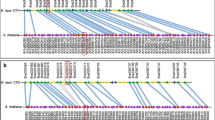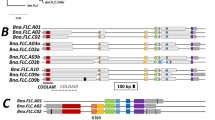Abstract
Previous locations of flowering time (FT) QTL in several Brassica species, coupled with Arabidopsis synteny, suggest that orthologues of the genes FLC, FY or CONSTANS might be the candidates. We focused on FLC, and cloned paralogous copies in Brassica oleracea, obtained their genomic DNA sequences, and confirmed their locations relative to those of known FT-QTL by genetical mapping. They varied in total length mainly due to the variable size of the first and last introns. A high level of identity was observed among Brassica FLC genes at the amino acid level but non-synonymous differences were present. Comparative analysis of the promoter and intragenic regions of BoFLC paralogues with Arabidopsis FLC revealed extensive differences in overall structure and organisation but showed high conservation within those segments known to be essential in regulating FLC expression. Four B. oleracea FLC copies (BoFLC1, BoFLC3, BoFLC4 and BoFLC5) were located to their respective linkage groups based on allelic sequence variation in lines from a doubled haploid population. All except BoFLC4 were within the confidence intervals of known FT-QTL. Sequence data indicated that relevant non-synonymous polymorphisms were present between parents A12DHd and GDDH33 for BoFLC genes. However, BoFLC alleles segregated independently of FT in backcrosses while the study provided evidence that BoFLC4 and BoFLC5 contain premature stop codons and so could not contribute to flowering time variation. Therefore, there is strong evidence against any of the 4 BoFLC being FT-QTL candidates in this population.







Similar content being viewed by others
References
Axelsson T, Shavorskaya O, Lagercrantz U (2001) Multiple flowering time QTLs within several Brassica species could be the result of duplicated copies of one ancestral gene. Genome 44:856–864
Ayele M, Haas BJ, Kumar N, Wu H, Aken SV, Utterback TR, Wortman JR, White OR, Town CD (2005) Whole genome shotgun sequencing of Brassica oleracea and its application to gene discovery and annotation in Arabidopsis. Genome Res 15:487–495
Bastow R, Myine JS, Lister C, Lippman Z, Martienssen RA, Dean C (2004) Vernalization requires epigenetic silencing of FLC by histone methylation. Nature 427:164–167
Bohuon EJR, Ramsay LD, Craft JA, Arthur AE, Marshal DF, Lydiate DJ, Kearsey MJ (1998) The association of flowering time quantitative trait loci with duplicated regions and candidate loci in Brassica oleracea. Genetics 150:393–401
Cavell AC, Lydiate DJ, Parkin IAP, Dean C, Trick M (1998) Collinearity between a 30-centimorgan segment of Arabidopsis thaliana chromosome 4 and duplicated regions within the Brassica napus genome. Genome 41:62–69
Gazzani S, Gendall AR, Lister C, Dean C (2003) Analysis of the molecular basis of flowering time variation in Arabidopsis accessions. Plant Physiol 132:1107–1114
Henderson IR, Shindo C, Dean C (2003) The need for winter in the switch to flowering. Annu Rev Genet 37:371–392
Hepworth SR, Valverde F, Ravenscroft D, Mouraduv A, Coupland G (2002) Antagonistic regulation of flowering time gene SOC1 by CONSTANS and FLC via separate promoter motifs. EMBO J 21:4327–4337
Higo K, Ugawa Y, Iwamoto M, Korenaga T (1999) Plant cis-acting regulatory DNA elements (PLACE) database. Nucleic Acids Res 27:297–300
Kimura M (1980) A simple method for estimating evolutionary rates of base substitutions through comparative studies of nucleotide sequences. J Mol Evol 16:111–120
Kole C, Quijada P, Michaels SD, Amasino RM, Osborn TC (2001) Evidence for homology of flowering time genes VFR2 from Brassica rapa and FLC from Arabidopsis thaliana. Theor Appl Genet 102:425–430
Kumar S, Tamura K, Nei M (2004) MEGA3: integrated software for molecular evolutionary genetics analysis and sequence alignment. Brief Bioinform 5:150–163
Lagercrantz U (1998) Comparative mapping between Arabidopsis thaliana and Brassica nigra indicates that Brassica genomes have evolved through extensive genome replication accompanied by chromosome fusions and frequent rearrangements. Genetics 150:1217–1228
Lagercrantz U, Axelsson T (2000) Rapid evolution of the family of CONSTANS LIKE genes in plants. Mol Biol Evol 17:1499–1507
Lagercrantz U, Lydiate DJ (1996) Comparative genome mapping in Brassica. Genetics 144:1903–1910
Lagercrantz U, Putterill J, Coupland G, Lydiate D (1996) Comparative mapping in Arabidopsis and Brassica, fine scale genome collinearity and congruence of genes controlling flowering time. Plant J 9:13–20
Levy YY, Dean C (1998) The transition to flowering. Plant Cell 10:1973–1989
Li Z, Zhao L, Cui C, Kai G, Zhang L, Sun X, Tang K (2005) Molecular cloning and characterization of an anti-bolting related gene (BrpFLC) from Brassica rapa ssp. pekinensis. Plant Sci 168:407–413
Lin S, Wang J, Poon S, Su C, Wang S, Chiou T (2005) Differential regulation of FLOWERING LOCUS C expression by vernalization in cabbage and Arabidopsis. Plant Physiol 137:1037–1048
Lukens LN, Quijada PA, Udall J, Pires JC, Schranz ME, Osborn TC (2004) Genome redundancy and plasticity within ancient and recent Brassica crop species. Biol J Linn Soc 82:665–674
Martynov VV, Khavkin EE (2004) Two homologs of the FLOWERING LOCUS C gene from leaf mustard (Brassica juncea). Russ J Plant Physiol 51:234–240
Michaels SD, Amasino RM (1999) FLOWERING LOCUS C encodes a novel MADS domain protein that acts as a repressor of flowering. Plant Cell 11:949–956
Michaels SD, Amasino RM (2000) Memories of winter: vernalization and the competence to flower. Plant Cell Environ 23:1145–1153
Michaels SD, He Y, Scortecci KC, Amasino RM (2003) Attenuation of Flowering Locus C activity as a mechanism for the evolution of summer-annual flowering behavior in Arabidopsis. Proc Natl Acad Sci USA 100:10102–10107
Michaels SD, Himelblau E, Kim SY, Shomburg FM, Amasino RM (2005) Integration of flowering signals in winter-annual Arabidopsis. Plant Physiol 137:149–156
Okazaki K, Sakamoto K, Kikuchi R, Saito A, Togashi E, Kuginuki Y, Matsumoto S, Hirai M (2007) Mapping and characterization of FLC homologs and QTL analysis of flowering time in Brassica oleracea. Theor Appl Genet 114:595–608
O’Neil MC, Bancroft I (2000) Comparative physical mapping of segments of the genome of Brassica oleracea var. alboglabra that are homoelogous to sequenced regions of chromosomes 4 and 5 of Arabidopsis thaliana. Plant J 23:233–243
Osborn TC, Kole C, Parkin IAP, Sharpe AG, Kuiper M, Lydiate DJ, Trick M (1997) Comparison of flowering time genes in Brassica rapa, B. napus and Arabidopsis thaliana. Genetics 146:1123–1129
Parenicova L, Folter SD, Kieffer M, Horner DS, Favalli C, Busscher J, Cook HE, Ingram RM, Kater MM, Davies B, Angenent GC, Colombo L (2003) Molecular and phylogenetic analyses of the complete MADS-box transcription factor family in Arabidopsis: new openings to the MADS world. Plant Cell 15:1538–1551
Parkin AP, Lydiate DJ, Trick M (2002) Assessing the level of collinearity between Arabidopsis thaliana and Brassica napus for A. thaliana chromosome 5. Genome 45:356–366
Parkin IAP, Gulden SM, Sharpe AG, Lukens L, Trick M, Osborn TC, Lydiate DJ (2005) Segmental structure of the Brassica napus genome based on comparative analysis with Arabidopsis thaliana. Genetics 171:765–781
Pires JC, Zhao J, Schranz ME, Leon EJ, Quijada PA, Lukens LN, Osborn TC (2004) Flowering time divergence and genomic rearrangments in resynthesized Brassica polyploids (Brassicaceae). Biol J Linn Soc 82:675–688
Quiros CF, Grellet F, Sadowski J, Suzuki T, Li G, Wroblewski T (2001) Arabidopsis and Brassica comparative genomics: sequence, structure and gene content in the ABI1-Rps2-Ck1 chromosomal segment and related regions. Genetics 157:1321–1330
Rae AM, Howell EC, Kearsey MJ (1999) More QTL for flowering time revealed by substitution lines in Brassica oleracea. Heredity 83:586–596
Ramsay LD, Jenings DE, Bohuon EJR, Arthur AE, Lydiate DJ, Kearsey MJ, Marshall DF (1996) The construction of a substitution library of recombinant backcross lines in Brassica oleracea for the precision mapping of quantitative trait loci. Genome 39:558–567
Rana D, Boogaart TV, O’Neill CM, Hynes L, Bent E, Macpherson L, Park JY, Lim YP, Bancroft I (2004) Conservation of the microstructure of genome segments in Brassica napus and its diploid relatives. Plant J 40:725–733
Ratcliffe OJ, Nadzan GC, Reuber TL, Riechmann JL (2001) Regulation of flowering in Arabidopsis by an FLC homologue. Plant Physiol 126:122–132
Ratcliffe OJ, Kumimoto RW, Wong BJ, Riechmann JL (2003) Analysis of the Arabidopsis MADS AFFECTING FLOWERING gene family: MAF2 prevents vernalization by short periods of cold. Plant Cell 15:1159–1169
Razi H (2006) Characterising paralogues of FLOWERING LOCUS C in Brassica oleracea. PhD Dissertation, University of Birmingham
Roberts LS, Robson F, Sharpe A, Lydiate D, Coupland G (1998) Conserved structure and function of the Arabidopsis flowering time gene CONSTANS in Brassica napus. Plant Mol Biol 37:763–772
Salathia NS (2003) Regulation of biological clocks in Brassica oleracea and Arabidopsis thaliana. PhD Dissertation, University of Warwick
Schranz ME, Quijada P, Sung S, Lukens L, Amasino R, Osborne TC (2002) Characterization and effects of the replicated flowering time gene FLC in Brassica rapa. Genetics 162:1457–1468
Sebastian RL, Howell EC, King GJ, Marshal DF, Kearsey MJ (2000) An integrated AFLP and RFLP Brassica oleracea linkage map from two morphologically distinct doubled-haploid mapping populations. Theor Appl Genet 100:75–81
Shahmuradov IA, Solovyev VV, Gammerman AJ (2005) Plant promoter prediction with confidence estimation. Nucleic Acids Res 33:1069–1076
Sheldon CC, Burn JE, Perez PP,Metzger J, Edwards JA, Peacock WJ, Dennis ES (1999) The FLF MADS Box Gene: A repressor of flowering in Arabidopsis regulated by vernalization and methylation. Plant Cell 11:445–458
Sheldon CC, Finnegan EJ, Rouse DT, Tadege M, Bagnall DJ, Helliwell CA, Peacock WJ, Dennis ES (2000a) The control of flowering by vernalization. Curr Opin Plant Biol 3:418–422
Sheldon CC, Rouse DT, Finnegan EJ, Peacock WJ, Dennis EC (2000b) The molecular basis of vernalization: the central role of FLOWERING LOCUS C (FLC). Proc Natl Acad Sci USA 97:3753–3758
Sheldon CC, Conn AB, Dennis ES, Peacock WJ (2002) Different regulatory regions are required for the vernalization-induced repression of FLOWERING LOCUS C and for the epigenetic maintenance of repression. Plant Cell 14:2527–2537
Shindo C, Aranzana MJ, Lister C, Baxter C, Nicholls C, Nordborg M, Dean C (2005) Role of FRIGIDA and FLOWERING LOCUS C in determining variation in flowering time of Arabidopsis. Plant Physiol 138:1163–1173
Smith RF, Wiese BA, Wojzynski MK, Davison DB, Worley KC (1996) BCM search launcher—An integrated interface to molecular biology data base search and analysis services available on the World Wide Web. Genome Res 6:454–462
Sung S, Amasino RM (2005) Remembering winter: toward a molecular understanding of vernalization. Annu Rev Plant Biol 56:491–508
Suzuki T, Grellet F, Potter D, Li G, Quiros CF (2003) Structure, sequence, and phylogeny of the members of the Ck1 gene family in Brassica oleracea and Arabidopsis thaliana (Brassicaceae). Plant Sci 164:735–742
Tadege M, Sheldon CC, Helliwell CA, Stoutjesdijk P, Dennis ES, Peacock WJ (2001) Control of flowering time by FLC orthologues in Brassica napus. Plant J 28:545–553
Thompson JD, Higgins DG, Gibson TJ (1994) CLUSTALW: improving the sensitivity of the progressive multiple sequence alignments through sequence weighting, position-specific gap penalties and weight matrix choice. Nucleic Acids Res 22:4673–4680
Wendel JF (2000) Genome evolution in polyploids. Plant Mol Biol 42:225–249
Yang TJ, Kim JS, Lim KB, Kwon SJ, Kim JA, Jin M, Park JY, Lim MH, Kim HI, Kim SH, Lim YP, Park BS (2005) The Korea Brassica genome project: a glimpse of the Brassica genome based on comparative genome analysis with Arabidopsis. Comp Funct Genomics 6:138–146
Yang TJ, Kim JS, Kwon SJ, Lim KB, Choi BS, Kim JA, Jin M, Park JY, Lim MH, Kim HI, Lim YP, Kang JJ, Hong JH, Kim CB, Bhak J, Bancroft I, Park BS (2006) Sequence-level analysis of the diploidization process in the triplicated FLOWERING LOCUS C region of Brassica rapa. Plant Cell 18:1339–1347
Acknowledgments
This work was supported by a grant from the Iranian Ministry of Science, Research and Technology to H. Razi, We would like to express our thanks to colleagues at Warwick HRI (G. Barker, G. King, G. Teakle) for access to the BACs and general advice.
Author information
Authors and Affiliations
Corresponding author
Additional information
Communicated by A. Bervillé.
Rights and permissions
About this article
Cite this article
Razi, H., Howell, E.C., Newbury, H.J. et al. Does sequence polymorphism of FLC paralogues underlie flowering time QTL in Brassica oleracea?. Theor Appl Genet 116, 179–192 (2008). https://doi.org/10.1007/s00122-007-0657-3
Received:
Accepted:
Published:
Issue Date:
DOI: https://doi.org/10.1007/s00122-007-0657-3




